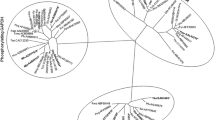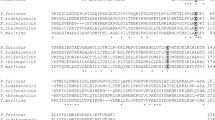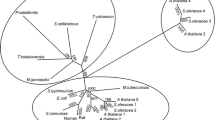Abstract
Streptomyces arenae produces the antibiotic pentalenolactone, a highly specific inhibitor of glyceraldehyde-3-phosphate dehydrogenase (GAPDH). During the phase of pentalenolactone production,S. arenae expresses a pentalenolactone-insensitive GAPDH isoform; otherwise, a pentalenolactone-sensitive form is expressed. The gene of the pentalenolactone-insensitive GAPDH was cloned and sequenced. Regulatory elements typical for genes encoding antibiotic resistance and production are localized upstream and downstream of the open reading frame. No expression of pentalenolactone-insensitive GAPDH was detected inStreptomyces lividans transformed with the gene. InEscherichia coli, the gene was expressed from an inducedlac promoter. Amino-terminal sequencing of the heterologously expressed GAPDH proved its identity with pentalenolactone-insensitive GAPDH fromS. arenae. Sequence comparisons with GAPDH from other organisms showed a close relationship to GAPDH of plant chloroplasts, of other gram-positive bacteria, and of thermophilic gram-negative bacteria. Pentalenolactone-insensitive GAPDH differs from all closely related GAPDHs only in a few residues, none of which are directly involved in catalysis or substrate binding. The total amino acid composition is more similar to GAPDH of thermophilic species than to that of mesophilic species. The purified enzyme was moderately thermotolerant, which could be a side effect of the structural changes causing pentalenolactone-resistance.
Similar content being viewed by others
Abbreviations
- GAP :
-
Glyceraldehyde-3-phosphate
- GAPDH :
-
Glyceraldehyde-3-phosphate dehydrogenase
References
Argos P, Rossmann MG, Grau UM, Zuber H, Frank G, Tratschin JD (1979) Thermal stability and protein structure. Biochemistry 18:5698–5703
Bibb MJ, Cohen SN (1982) Gene expression inStreptomyces: construction and application of promoter-probe plasmid vectors inStreptomyces lividans. Mol Gen Genet 187:265–277
Bibb MJ, Bibb MJ, Ward JM, Cohen SN (1985) Nucleotide sequences encoding and promoting expression of three antibiotic resistance genes indigenous toStreptomyces. Mol Gen Genet 199:26–36
Biesecker G, Harris JI, Thierry JC, Walker JE, Wonacott AJ (1977) Sequence and structure ofd-glyceraldehyde-3-phosphate dehydrogenase fromBacillus stearothermophilus. Nature 266:328–333
Bradford MM (1976) A rapid and sensitive method for the quantitation of microgram quantities of protein utilizing the principle of protein-dye binding. Anal Biochem 72:248–254
Cane DE, Sohng J-K (1989) Inhibition of glyceraldehyde-3-phosphate dehydrogenase by pentalenolactone: kinetic and mechanistic studies. Arch Biochem Biophys 270:50–61
Cane DE, Sohng J-K (1994) Inhibition of glyceraldehyde-3-phosphate dehydrogenase by pentalenolactone. 2. Identification of the site of alkylation by tetrahydropentalenolactone. Biochemistry 33:6524–6530
Dittrich W, Schrempf H (1992) The unstable tetracycline resistance gene ofStreptomyces lividans 1326 encodes a putative protein with similarities to translational elongation factors and Tet(M) and Tet(O) proteins. Antimicrob Agents Chemother 36:1119–1124
Endo A, Hasumi K, Sakai K, Kanbe T (1985) Specific inhibition of glyceraldehyde-3-phosphate dehydrogenase by koningic acid (heptelidic acid). J Antibiotics 38:920–925
Fröhlich K-U, Wiedmann M, Lottspeich F, Mecke D (1989) Substitution of a pentalenolactone-sensitive glyceraldehyde-3-phosphate dehydrogenase by a genetically distinct resistant isoform accompanies pentalenolactone production inStreptomyces arenae. J Bacteriol 171:6696–6702
Gilbert D (1990) Tree Draw Deck. Published electronically on the Internet; available via anonymous ftp from ftp.bio.indiana.edu
Hartmann S, Neeff J, Heer U, Mecke D (1978) Arenaemycin (pentalenolactone): a specific inhibitor of glycolysis. FEBS Lett 93:339–342
Higgins DG, Bleasby AJ, Fuchs R (1992) Clustal V: improved software for multiple sequence alignment. Comput Appl Biosci 8:189–191
Hopwood DA, Kieser T, Wright HM, Bibb MJ (1983) Plasmids, recombination and chromosome mapping inStreptomyces lividans 66. J Gen Microbiol 129:2257–2269
Hopwood DA, Bibb MJ, Chapter KF, Kieser T, Bruton CJ, Kieser HM, Lydiate DJ, Smith CP, Ward JM, Schrempf H (1985) Genetic manipulation of Streptomyces. A laboratory manual. John Innes Foundation, Norwich
Jaurin B, Cohen SN (1985)Streptomyces containEscherichia coli-type A+T rich promoters having novel structural features. Gene 39:191–201
Jones JMT, Harris JI (1972) Glyceraldehyde-3-phosphate dehydrogenase: amino acid sequence of enzyme from baker's yeast. FEBS Lett 22:185–189
Keller-Schierlein W, Lemke J, Nyfeler R, Zähner H (1972) Stoffwechselprodukte von Mikroorganismen. Arch Microbiol 84: 301–316
Maniatis T, Fritsch EF, Sambrook J (1982) Molecular cloning: a laboratory manual. Cold Spring Harbor Laboratory, Cold Spring Harbor, New York
Mann K, Mecke D (1979) Inhibition of spinach glyceraldehyde-3-phosphate dehydrogenase by pentalenolactone. Nature 282: 535–536
Matthews BW, Nicholson H, Becktel WJ (1987) Enhanced protein thermostability from site-directed mutations that decrease the entropy of unfolding. Proc Natl Acad Sci USA 84:6663–6667
Maurer K-H, Pfeiffer F, Zehender H, Mecke D (1983) Characterization of two glyceraldehyde-3-phosphate dehydrogenase isoenzymes from pentalenolactone producerStreptomyces arenae. J Bacteriol 153:930–936
Moras D, Olsen KW, Sabesan MN, Buehner M, Ford GC, Rossman MG (1975) Studies of asymmetry in the three-dimensional structure of lobsterd-glyceraldehyde-3-phosphate dehydrogenase. J Biol Chem 250:9137–9162
Okanishi M, Suzuki K, Umezawa H (1974) Formation and reversion of streptomycete protoplasts: cultural condition and morphological study. J Gen Microbiol 80:389–400
Rentier-Delrue F, Mande SC, Moyens S, Terpstra P, Mainfroid V, Goraj K, Lion M, Hol WGJ, Martial JA (1993) Cloning and overexpression of the triosephosphate isomerase genes from psychrophilic and thermophilic bacteria. Structural comparison of the predicted protein sequences. J Mol Biol 229:85–93
Rosenberg M, Court D (1979) Regulatory sequences involved in the promotion and termination of RNA transcription. Annu Rev Genet 13:319–353
Sakai K, Hasumi K, Endo A (1988) Inactivation of rabbit muscle glyceraldehyde-3-phosphate dehydrogenase by koningic acid. Biochim Biophys Acta 952:297–303
Skarzynski T, Moody PCE, Wonacott AJ (1987) Structure of hologlyceraldehyde-3-phosphate dehydrogenase fromBacillus stearothermophilus at 1.8 Å resolution. J Mol Biol 193:171–187
Watanabe H, Hasumi K, Fukushima Y, Sakai K, Endo A (1993) Cloning of two isoenzymes ofTrichoderma konigii glyceraldehyde-3-phosphate dehydrogenase with different sensitivity to koningic acid. Biochim Biophys Acta 1172:43–48
Yanisch-Perron C, Vieira J, Messing J (1985) Improved M13 phage cloning vectors and host strains: nucleotide sequences of the M13mp 18 and pUC19 vectors. Gene 33:103–119
Author information
Authors and Affiliations
Corresponding author
Rights and permissions
About this article
Cite this article
Fröhlich, KU., Kannwischer, R., Rüdiger, M. et al. Pentalenolactone-insensitive glyceraldehyde-3-phosphate dehydrogenase fromStreptomyces arenae is closely related to GAPDH from thermostable eubacteria and plant chloroplasts. Arch. Microbiol. 165, 179–186 (1996). https://doi.org/10.1007/BF01692859
Received:
Accepted:
Issue Date:
DOI: https://doi.org/10.1007/BF01692859




